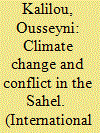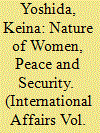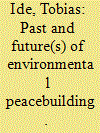|
|
|
Sort Order |
|
|
|
Items / Page
|
|
|
|
|
|
|
| Srl | Item |
| 1 |
ID:
191574


|
|
|
|
|
| Summary/Abstract |
A major challenge in the field of environmental peacebuilding is showing the impact of its initiatives. Questions emerge, such as what kind of postwar peacebuilding dimensions are more likely to be affected by natural resource management projects? Although quantitative studies assess the relation between natural resource management programmes and conflict, the question remains: what are the mechanisms involved in implementing projects designed for environmental peacebuilding? To answer these questions, a mixed methods research approach is chosen, combining four qualitative and quantitative methods to triangulate results. First, we identify a set of peacebuilding dimensions and mechanisms based in the literature that facilitate assessing the impact of sustainable land-use systems (SLUS) design in the post-peace agreement region of Caquetá, Colombia. Second, not only do we interview experts and practitioners at global, national (Colombia) and local (Department of Caquetá) levels in the fields of peacebuilding, natural resource management and environmental peacebuilding, we also conduct three workshops and a survey in Caquetá to prioritize dimensions and discover explanatory mechanisms. The case of Caquetá, Colombia, shows that peacebuilding dimensions, such as socio-economic inclusion (e.g. sustainable livelihoods), creation of governance scenarios, and building capacities for dialogue and a peace culture, should be addressed to take account of the impacts of SLUS projects in post-conflict peacebuilding.
|
|
|
|
|
|
|
|
|
|
|
|
|
|
|
|
| 2 |
ID:
191575


|
|
|
|
|
| Summary/Abstract |
Environmental stress contributes to food insecurity, poverty, forced migration and violent conflict in the Sahel, with climate change aggravating the situation. The production of gum arabic from the acacia tree increasingly aligns with the community stakeholders’ efforts to promote climate change mitigation, adaptation and resilience. Based on expert interviews and field observations in Niger, and a reading of relevant documents, I found that gum arabic production is valuable for conflict mitigation because it helps tackle the root causes of violent conflicts. The acacia gum tree is a natural soil fixer and multinational companies have coveted the resin from the tree, which is a rising commodity and a promising source of revenue for the local inhabitants. As different communities work together and cooperate with outside actors (government agencies, international partners, NGOs and businesses), the opportunities to build social cohesion around the tree increase. By facilitating ecological improvement, social inclusion and poverty alleviation, the promotion of gum arabic production, despite other issues such as bad natural resource governance, is a critical environmental peacebuilding strategy. Hence, suitable funding of massive afforestation with the acacia tree fits with community-based natural climate solutions to global humanitarian issues by protecting and restoring the local environment.
|
|
|
|
|
|
|
|
|
|
|
|
|
|
|
|
| 3 |
ID:
191571


|
|
|
|
|
| Summary/Abstract |
The geopolitical and geophysical realities of south Asia create a deep sense of paradox. On the one hand, territorial disputes and hyper-nationalism have resulted in some of the most militarized borders in the world. South Asia's international boundaries are subject to a range of conflicts, which includes high-level armed confrontations between India and Pakistan and low-level, yet deadly, incidents at the India–Bangladesh border. On the other hand, the region's ecology is inherently interlinked through shared rivers, glaciers and forests. South Asia's borders therefore present unique opportunities for environmental peacebuilding, as they are the epicentre of political conflicts as well as the source of transnational ecological connections. This article argues that grassroots processes of environmental peacebuilding can be used to build societal resistance to the rise of ethno-nationalistic populism in south Asia. Using interview data, the article tests concepts on pathways to environmental peacebuilding against underlying drivers of regional conflicts. The study suggests ways by which grassroots environmental initiatives on the Sundarbans forest between India and Bangladesh and the Thar desert between India and Pakistan can address the contemporary rise in nativist politics. The article contributes to existing literature by connecting theories on pathways to environmental peacebuilding to the ideational drivers of territorial and political conflicts. It adds to policy discussions by suggesting an ecological response to the contemporary rise of ethno-nationalistic populism in various regions of the world.
|
|
|
|
|
|
|
|
|
|
|
|
|
|
|
|
| 4 |
ID:
191570


|
|
|
|
|
| Summary/Abstract |
Environmental peacebuilding is the integration of natural resource management into conflict prevention, resolution and recovery so as to support peace and environmental sustainability. Most studies have been of cases where there is significant involvement of external (usually international) actors. They thus provide implicit support for liberal peacebuilding practice, which is itself the subject of much critique. Conversely, documented examples of environmental peacebuilding from below are rare. We analyse an endogenously emerging environmental peacebuilding institution, the customary tara bandu process in Timor-Leste. We explain the way tara bandu is used bottom-up to promote the sustainable use of natural resources and more peaceful relations. Tara bandu proves to be a successful, locally diverse environmental peacebuilding institution. We further show how recent attempts by international peacebuilders and state institutions to employ tara bandu have somewhat ignored the way it is deeply interwoven with local social and spiritual relations, and in so doing have jeopardized its legitimacy and efficacy. This suggests that attempts from outside actors to facilitate environmental peacebuilding may be constrained by a mismatch between theorized norms of social and environmental relations (such as ‘shared interests’) and local cultural particularities.
|
|
|
|
|
|
|
|
|
|
|
|
|
|
|
|
| 5 |
ID:
191569


|
|
|
|
|
| Summary/Abstract |
Environmental governance reform—especially in the minerals sector—has featured prominently in Sierra Leone's peacebuilding agenda. While reform has enhanced environmental governance capacity in ways that foster peace, it has also exacerbated conflict over the redistribution of extractive rights. This article examines one such conflict over tantalite in northern Sierra Leone. In the chiefdom of Sella Limba, violence erupted as local landowners and a multinational company utilized institutional hybridity—or the blending of informal–indigenous institutions with liberal reforms—to construct competing claims over mineral rights. The resulting uncertainty over the extractive ‘rules of the game’ accelerated conflict as stakeholders attempted to (re)negotiate the distributional consequences of institutional change in real time. International and national actors ultimately rejected hybrid institutional arrangements on the grounds that they distorted post-conflict reforms and undermined peace. Drawing on in-depth fieldwork, I retrace the conflict to provide an alternative perspective. I contend that institutional hybridity served as a necessary component of, rather than barrier to, peacebuilding because it 1) opened space for diverse political participation in post-conflict environmental governance and 2) promoted greater political accountability and integration. These outcomes have been theorized as ways in which environmental reform can facilitate post-conflict peace. This argument aims to advance environmental peacebuilding theory by examining the conditions under which environmental governance reform contributes to post-conflict peacebuilding.
|
|
|
|
|
|
|
|
|
|
|
|
|
|
|
|
| 6 |
ID:
191567


|
|
|
|
|
| Summary/Abstract |
Artisanal and small-scale mining (ASM) has long been a vital source of livelihoods for rural populations in the global South. Yet, it has also been linked to a host of social, political and environmental adversities, including violent conflict. As environmental peacebuilding increasingly stresses the importance of livelihood improvement as a means of fostering peace in conflict-affected extractive societies, ASM formalization has been identified as a solution to mitigate the sector's challenges, thereby addressing underlying causes of conflict. This article critically investigates the contribution of ASM formalization to sustainable peace by focusing on its impact on the livelihood dimension of peacebuilding. It analyses the livelihood impact of three formalization interventions in the diamond sectors of two countries: cooperatives in Liberia, and, in Sierra Leone, ethical sourcing schemes and a community-based natural resource management initiative. In line with calls for a paradigm shift from a narrow legalization-centred understanding of formalization to a broader approach that accounts for livelihood quality, the analysis presented here focuses on interventions that were informed by the ideal of improving the well-being of ASM workers and communities. We propose three pathways through which ASM formalization could potentially contribute to livelihood enhancement: income security, working conditions and community benefits. Based on fieldwork, this article highlights the challenges of generating livelihood improvements through formalization. Even when specifically designed to address the needs of ASM communities, during implementation, they risk prioritizing a narrow conceptualization of formalization and thus failing to become a conductor of transformative change.
|
|
|
|
|
|
|
|
|
|
|
|
|
|
|
|
| 7 |
ID:
191573


|
|
|
|
|
| Summary/Abstract |
Many modern conflicts, from Iraq to Yemen, have emerged as brutal wars in which state and non-state actors directly and indirectly target a wide array of civilian infrastructures, including water, energy and food systems. Similar to many twentieth-century wars, a common feature of the wars in the Middle East and North Africa in the twenty-first century has been the ‘civilianization’ of war, as civilian casualties far outnumbered battlefield deaths. We explore the targeting of civilian infrastructures in the Yemeni war (2011–2019) to explicate the connections between conflict, hunger and disease. We draw upon interviews with UN and humanitarian organizations, an original database tracking civilian infrastructure destruction, and a variety of print sources to document the extent and spatial distribution of the targeting of water, energy, agricultural and health systems in Yemen. We elucidate how the conduct of the Yemeni war has undermined human security and livelihoods and has created ethical, logistical and organizational challenges for humanitarian organizations and for advancing peacebuilding efforts. We find that after the 2011 popular uprising, some non-state actors targeted the energy sector; however, the scope and intensity of wartime targeting of civilian objects, particularly those associated with agriculture, fisheries and health, increased significantly once the Saudi-led coalition entered the war in 2015. Loss of livelihoods, internal displacement, currency depreciation, and blockades and sieges further intensified the wartime spread of hunger and disease. The targeting of civilian infrastructures significantly hinders peacebuilding efforts to restore basic services, rebuild livelihoods and strengthen governance mechanisms.
|
|
|
|
|
|
|
|
|
|
|
|
|
|
|
|
| 8 |
ID:
191566


|
|
|
|
|
| Summary/Abstract |
On 12 November 2019, the Special Jurisdiction for Peace (JEP), handed down a landmark decision in the case of ‘Katsa Su’ concerning the Awa indigenous group in Colombia. The Colombian conflict has particularly affected indigenous groups, such as the Awa people, and has also affected the territory in which they live. In this article, we explore the decision of the JEP, within a broader analysis of the Colombian peace agreement and consider how it might help us to think about the place of the environment in the Women, Peace and Security agenda and in international law. We call for a gendered and intersectional approach to environmental peacebuilding which is attentive to the importance of gender and different groups. Further, we highlight how the Colombian example shows how concepts such as relief, recovery and reparations are often confined in international law to women's recovery and redress with respect to sexual violence and yet, this conceptualization should be much broader. The Katsa Su case provides an example of the fact that reparations and redress must address other forms of violence, spiritual and ecological, which women also suffer in times of conflict.
|
|
|
|
|
|
|
|
|
|
|
|
|
|
|
|
| 9 |
ID:
191565


|
|
|
|
|
| Summary/Abstract |
Environmental peacebuilding is a rapidly growing field of research and practice at the intersection of environment, conflict, peace and security. Focusing on these linkages is crucial in a time when the environment is a core issue of international politics and the number of armed conflicts remains high. This article introduces a special issue with a particular emphasis on environmental opportunities for building and sustaining peace. We first detail the definitions, theoretical assumptions and intellectual background of environmental peacebuilding. The article then provides context for the special issue by briefly reviewing core findings and debates of the first two generations of environmental peacebuilding research. Finally, we identify knowledge gaps that should be addressed in the next generation of research, and to which the articles in this special issue contribute: bottom-up approaches, gender, conflict-sensitive programming, use of big data and frontier technology, and monitoring and evaluation.
|
|
|
|
|
|
|
|
|
|
|
|
|
|
|
|
| 10 |
ID:
191568


|
|
|
|
|
| Summary/Abstract |
Next to a broader agrarian reform, the Peace Accord signed between the Revolutionary Armed Forces of Colombia (FARC-EP) and the Colombian Government (2016) was designed to support the voluntary substitution of illicit crops in an attempt to fight drug trafficking. In the municipality of Miranda (Northern Cauca), over 1300 peasant families agreed to eradicate their coca crops and stop their work in coca fields as part of the National Comprehensive Program for the Substitution of Illicit Crops (PNIS). Nearly three years later, the programme has shown little progress based on complementary evidence. First, it has only embraced 38% of the families who declared their will to replace illicit crops; and second, it has delayed commitments regarding access to land and financial and technical assistance for alternative projects. Based on extensive ethnographic fieldwork, this article brings an insightful and original political ecology perspective to environmental peacebuilding, showing that the promised transformation for marginalized peasant communities has been neglected. We argue that initial solutions for substitution have not only been redirected to benefit green corporate agrarian projects but have also been gradually abandoned by the state, creating different forms of slow environmental violence.
|
|
|
|
|
|
|
|
|
|
|
|
|
|
|
|
| 11 |
ID:
191572


|
|
|
|
|
| Summary/Abstract |
Transboundary water relations in the Euphrates–Tigris (ET) basin are often marked by political confrontation and rivalry between Iraq, Syria and Turkey. Even in the absence of political stability, riparian states have remained in contact with one another over the ET rivers at different levels by establishing and revitalizing joint governance mechanisms. In these processes, multiple actors—ranging from bureaucracies and heads of state and government, to epistemic communities—have focused on cooperative socio-economic development aspects of otherwise divisive water-related matters in the basin. Hence, the article aims to examine various emerging actors and mechanisms, arguing that their co-existence in the basin demonstrates a case of ‘imperfect peace’. Since the invasion of Iraq in 2003 and with the start of the domestic unrest in Syria in 2011, transboundary water relations in the basin have been carried out within the context of an unstable international security environment, particularly with the emergence of the non-state armed groups who have used water as a weapon against their opponents. The article therefore addresses policy-relevant research questions, such as what kind of joint security mechanism the riparian states should create to cope with violent non-state actors who control water and infrastructure under the conditions of ‘imperfect peace’. In the same vein, the article analyses the strategic role that water plays in environmental peacebuilding and discusses the possible ways and means to improve the protection of water during and after armed conflicts.
|
|
|
|
|
|
|
|
|
|
|
|
|
|
|
|
|
|
|
|
|